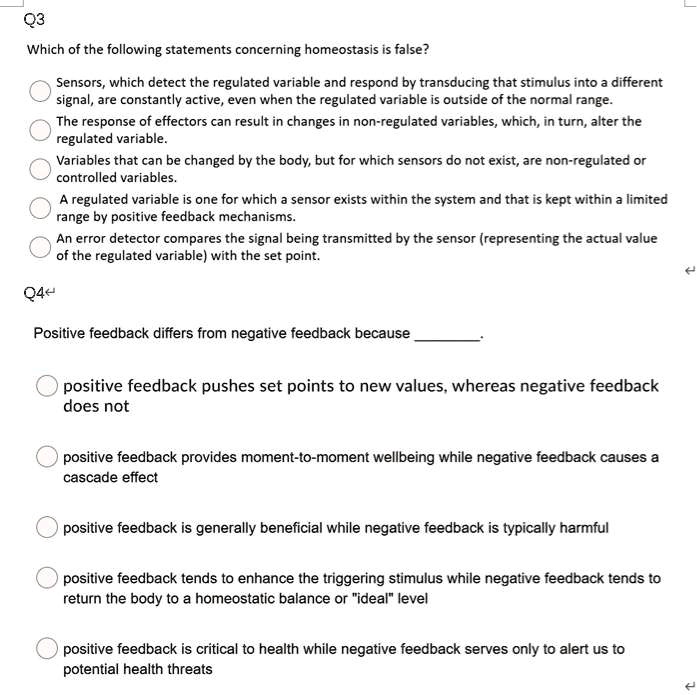Which Of The Following Statements Regarding Negative Feedback Is False

The seemingly innocuous multiple-choice question, "Which of the following statements regarding negative feedback is false?" is creating ripples across corporate training departments, academic psychology circles, and even online self-help communities. Its deceptive simplicity belies a complex web of misconceptions surrounding a crucial component of personal and professional growth: negative feedback.
At the heart of the debate lies a critical need for clarity regarding the nature and application of negative feedback. Misunderstandings can lead to ineffective communication, damaged relationships, and ultimately, hindered progress. This article aims to dissect the common fallacies and truths associated with negative feedback, drawing on research and expert opinions to provide a comprehensive understanding of this often-misunderstood concept.
The Anatomy of Negative Feedback
Negative feedback, in its purest form, is information highlighting discrepancies between desired outcomes and current performance. It serves as a corrective mechanism, guiding individuals and organizations toward improvement.
However, the term itself often carries a negative connotation, leading to resistance and defensiveness. This is largely due to how negative feedback is often delivered and perceived.
Effective negative feedback is not about criticism, but about constructive guidance. It focuses on specific behaviors and outcomes, not on personal attacks.
Common Misconceptions Debunked
One prevalent misconception is that negative feedback is inherently demotivating. While poorly delivered feedback can certainly be demotivating, well-crafted and timely negative feedback can actually increase motivation by providing clarity and a roadmap for improvement.
Another common myth is that avoiding negative feedback altogether is the best approach. This avoidance, often stemming from a desire to protect feelings, ultimately deprives individuals of valuable learning opportunities. Stifling constructive criticism can lead to stagnation and a failure to address critical issues.
The belief that negative feedback should always be delivered privately is also not universally true. While privacy is often preferred, in certain team settings, public feedback can be beneficial for demonstrating accountability and promoting transparency. The appropriateness of public versus private feedback depends heavily on the context and the individuals involved.
The Importance of Specificity
Vague or generalized feedback, such as "You need to improve your communication skills," is largely ineffective. Specificity is paramount when delivering negative feedback.
Instead of broad generalizations, provide concrete examples of behaviors that need improvement. For instance, "During the presentation, you spoke too quickly and didn't make enough eye contact with the audience."
This level of detail allows the recipient to understand exactly what needs to be changed and how to go about making those changes.
The Role of Timing and Delivery
The timing of negative feedback is also crucial. Delivering feedback immediately after an event, while it's still fresh in everyone's minds, tends to be more impactful.
However, delivering feedback when emotions are running high can be counterproductive. It's often best to wait until both the giver and receiver are calm and receptive.
Furthermore, the delivery method matters. A calm, respectful, and empathetic tone is far more effective than an accusatory or judgmental one. Focus on collaboration and finding solutions together.
Expert Perspectives
Dr. Anna Richards, a leading organizational psychologist at the University of California, Berkeley, emphasizes the importance of framing negative feedback as a growth opportunity. "When individuals view feedback as a chance to learn and develop, they are more likely to embrace it and use it to improve," she states.
Harvard Business Review has published numerous articles highlighting the benefits of radical candor, a management philosophy that emphasizes both caring personally and challenging directly.
Radical candor encourages managers to provide honest and direct feedback, even when it's uncomfortable, but to do so with empathy and compassion.
Navigating the Challenges
One of the biggest challenges associated with negative feedback is overcoming defensiveness. People naturally tend to resist criticism, even when it's well-intentioned.
Creating a culture of open communication and psychological safety is essential for mitigating defensiveness. This involves fostering an environment where individuals feel comfortable receiving feedback and where mistakes are viewed as learning opportunities.
Actively seeking feedback and demonstrating a willingness to improve can also help to build trust and reduce defensiveness.
Another challenge is ensuring that negative feedback is delivered equitably and fairly. Biases, both conscious and unconscious, can influence how feedback is given and received.
Organizations should implement training programs to help managers recognize and address their biases and to provide them with the skills to deliver feedback in a fair and objective manner.
Regularly evaluating the feedback process and seeking input from employees can also help to identify and address any inequities.
Looking Ahead
The future of negative feedback lies in embracing a more nuanced and holistic approach. Moving beyond simplistic statements and focusing on creating a culture of continuous improvement is key.
Technology may also play a role in facilitating more effective feedback. AI-powered tools can analyze communication patterns and provide personalized feedback on delivery and tone.
Ultimately, the goal is to transform negative feedback from a dreaded chore into a valuable tool for personal and professional growth. By understanding the nuances and avoiding common pitfalls, we can harness the power of feedback to unlock our full potential.



![Which Of The Following Statements Regarding Negative Feedback Is False [ANSWERED] 22 Which of the following statements is FALSE regarding the](https://media.kunduz.com/media/sug-question-candidate/20230920150204894475-4569668.jpg?h=512)



![Which Of The Following Statements Regarding Negative Feedback Is False [ANSWERED] Which of the following statements regarding enzymes is FALSE](https://media.kunduz.com/media/sug-question-candidate/20231009150201530337-4537299.jpg?h=512)

